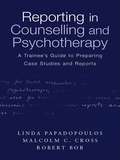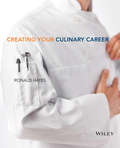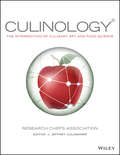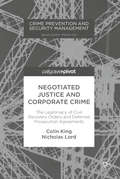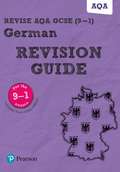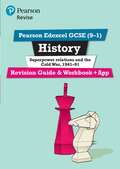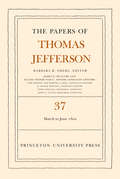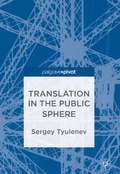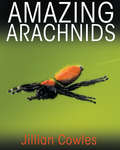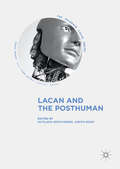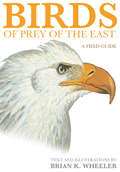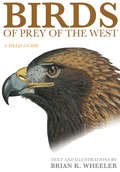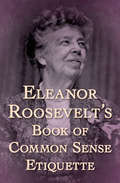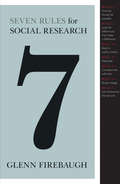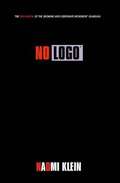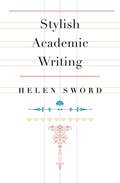- Table View
- List View
Reporting In Counselling And Psychotherapy: A Trainee's Guide To Preparing Case Studies And Reports
by Linda Papadopulos Malcolm C. Cross Robert BorTrainee therapists need to show practical competence through the production of client reports and case studies. Reporting in Counselling and Psychotherapy is a unique hands-on guide to this element of practical work. Using clinical examples to guide the reader, and a detailed analysis of case study and process report writing, it will show how to present clear, concise and properly presented reports. The book will be an invaluable tool, not only for those embarking on practical training in psychotherapy, counselling and psychology, but also for trainers in these areas and for clinicians writing clinical reports or case presentations.
Creating Your Culinary Career
by The Culinary Institute of America Ronald HayesA must-have resource for anyone crafting a career in the culinary arts Ronald Hayes, the Career Development Manager with The Culinary Institute of America, explores the broad scope of jobs available in the culinary field. Building your culinary skills as a novice, discovering your specialization as a journeyman, and establishing your interests as you master your career path, Creating Your Culinary Career offers a framework for career exploration, development, and growth. This book offers insider information on all of the regular staff positions available in the culinary field, including traditional restaurants, catering facilities, and institutional facilities; front of the house, bakeshop, and food and beverage outlets; and food communications, media, and sales positions. It then helps readers establish goals, design resumes, and develop interview skills for landing that perfect job. The ideal career guide for aspiring culinary professionals, this book helps readers discover the ideal career path by building skills and setting goals Written by The Culinary Institute of America's Career Development Manager, this book celebrates the passion, persistence, and drive required to succeed in one of today's most exciting careers For anyone beginning a career in the culinary arts, Creating Your Culinary Career features must-have information for the aspiring food professional.
Culinology: The Intersection of Culinary Art and Food Science
by Research Chefs AssociationCulinology: The Intersection of Culinary Art and Food Science will demonstrate how the disciplines of culinary arts and food science work hand in hand in the research and development of new manufactured food products for the commercial, retail, and foodservice industries. It will be the authoritative source that will add value and relevance to this growing discipline and its practitioners. Integrating culinary arts with food science and technology, this book provides the best strategy for developing successful food products on a large scale. Real-world applications and business models ground the book and clearly illustrate how the concepts and theories work in business and industry.
Negotiated Justice and Corporate Crime
by Colin King Nicholas LordThis book argues that there is a strong normative argument for using the criminal law as a primary response to corporate crime. In practice, however, corporate crimes are rarely dealt with through criminal sanctioning mechanisms. Rather, the preference – for both prosecutors and corporates – appears to be on negotiating out of the criminal process. Reflecting this emphasis on negotiation, this book examines the use of Civil Recovery Orders and Deferred Prosecution Agreements as responses to corporate crime, and discusses a variety of UK case studies. Drawing upon legal and criminological backgrounds, and with an emphasis on the conceptual frameworks of ‘negotiated justice’ and ‘legitimacy’, the authors examine the law, policy and practice of these enforcement responses. They offer an original, theoretically-informed analysis which is accessible to practitioners and researchers.
Revise AQA GCSE (Revise AQA GCSE MFL 16)
by Harriette LanzerOur revision resources are the smart choice for those revising for AQA GCSE German. This book will help you to: • Speed up your revision with summaries of key concepts delivered in short memorable chunks • Track your revision progress with at-a-glance check boxes • Enhance your speaking and listening skills with audio files, available to download • Check your understanding with worked examples showing you how to lay out your answers for reading, writing, speaking and listening • Develop your technique with exam-style practice questions and full answers • Practice your grammar and vocabulary with dedicated sections.
Revise Edexcel GCSE (Revise Edexcel GCSE History 16)
by Brian DowseOur revision resources are the smart choice for those revising for Edexcel GCSE (9–1) Superpower Relations and the Cold War, 1941–91. This book will help you to: • Organise your revision with the one-topic-per-page format • Speed up your revision with summary notes in short, memorable chunks • Track your revision progress with at-a-glance check boxes • Check your understanding with worked examples • Develop your exam technique with exam-style practice questions and full answers.
The Papers of Thomas Jefferson, Volume 37: 4 March to 30 June 1802 (Papers of Thomas Jefferson #37)
by Thomas Jefferson Barbara ObergThis volume opens on 4 March 1802, the first anniversary of Thomas Jefferson's inauguration as the nation's third president, and closes on 30 June. In March, a delegation of Seneca Indians comes to Washington to discuss their tribe's concerns, and Jefferson names a commissioner to handle a land sale by Oneida Indians to the state of New York. In April, the Senate ratifies a treaty with the Choctaw nation for a wagon road across their lands. Jefferson worries about an increasingly dictatorial France taking back control of New Orleans, prompting him to the intemperate remark that he would "marry" America's fortunes to the British fleet. Charles Willson Peale sends him sketches of the skull of a prehistoric bison found in Kentucky. During the closing, and very frustrating, weeks of Congress, he distracts himself with a cipher devised by Robert Patterson. He prepares lists of books to be purchased for the recently established Library of Congress and also obtains many titles for his own collection. Even while he is in Washington occupied with matters of state, Jefferson has been keeping close watch on the renovations at Monticello. In May, he has Antonio Giannini plant several varieties of grapes in the southwest vineyard, and he orders groceries, molasses, dry Lisbon wine, and cider to be shipped to Monticello in time for his arrival. He looks forward "with impatience" to the moment he can embrace his family once more.
Translation in the Public Sphere
by Sergey TyulenevThis book brings together the study of translation with public sphere theory, in order to discuss social communication as it really happens. Through illuminating examples and case studies, translation is shown to be a mediating mechanism in all public debate conducted both within one society and between societies. The author offers a detailed discussion of the kinds of translation most relevant to public sphere communication and their properties. Throughout, he argues persuasively that it is impossible to study the public sphere without taking account of translation in it, and that the interaction between the public as a collective inevitably involves translation. Further, the author suggests new methodological approaches to studying not only translation in the public sphere but public debate itself as a kind of translation. Building on the achievements of both the public sphere scholarship and Translation Studies, this work fills a significant lacuna in existing literature and will set the agenda for future studies at the intersection of the two. It will provide an invaluable resource for scholars and students of the public sphere and translation, as well as academics in the broader fields of sociology, political science and communication.
Translation in the Public Sphere
by Sergey TyulenevThis book brings together the study of translation with public sphere theory, in order to discuss social communication as it really happens. Through illuminating examples and case studies, translation is shown to be a mediating mechanism in all public debate conducted both within one society and between societies. The author offers a detailed discussion of the kinds of translation most relevant to public sphere communication and their properties. Throughout, he argues persuasively that it is impossible to study the public sphere without taking account of translation in it, and that the interaction between the public as a collective inevitably involves translation. Further, the author suggests new methodological approaches to studying not only translation in the public sphere but public debate itself as a kind of translation. Building on the achievements of both the public sphere scholarship and Translation Studies, this work fills a significant lacuna in existing literature and will set the agenda for future studies at the intersection of the two. It will provide an invaluable resource for scholars and students of the public sphere and translation, as well as academics in the broader fields of sociology, political science and communication.
Amazing Arachnids
by Jillian CowlesA richly illustrated and up-close look at the secret lives of spiders and other arachnidsThe American Southwest is home to an extraordinary diversity of arachnids, from spitting spiders that squirt silk over their prey to scorpions that court one another with kissing and dancing. Amazing Arachnids presents these enigmatic creatures as you have never seen them before. Featuring a wealth of color photos of more than 300 different kinds of arachnids from eleven taxonomic orders--both rare and common species—this stunningly illustrated book reveals the secret lives of arachnids in breathtaking detail, including never-before-seen images of their underground behavior.Amazing Arachnids covers all aspects of arachnid biology, such as anatomy, sociality, mimicry, camouflage, and venoms. You will meet bolas spiders that lure their victims with fake moth pheromones, fishing spiders that woo their mates with silk-wrapped gifts, chivalrous cellar spiders, tiny mites, and massive tarantulas, as well as many others. Along the way, you will learn why arachnids are living fossils in some respects and nimble opportunists in others, and how natural selection has perfected their sensory structures, defense mechanisms, reproductive strategies, and hunting methods.Covers more than 300 different kinds of arachnids, including ones new to scienceFeatures more than 750 stunning color photosDescribes every aspect of arachnid biology, from physiology to biogeographyIllustrates courtship and mating, birth, maternal care, hunting, and defenseIncludes first-ever photos of the underground lives of schizomids and vinegaroonsProvides the first organized guide to macroscopic mites, including photos of living mites for easy reference
Amazing Arachnids
by Jillian CowlesA richly illustrated and up-close look at the secret lives of spiders and other arachnidsThe American Southwest is home to an extraordinary diversity of arachnids, from spitting spiders that squirt silk over their prey to scorpions that court one another with kissing and dancing. Amazing Arachnids presents these enigmatic creatures as you have never seen them before. Featuring a wealth of color photos of more than 300 different kinds of arachnids from eleven taxonomic orders--both rare and common species—this stunningly illustrated book reveals the secret lives of arachnids in breathtaking detail, including never-before-seen images of their underground behavior.Amazing Arachnids covers all aspects of arachnid biology, such as anatomy, sociality, mimicry, camouflage, and venoms. You will meet bolas spiders that lure their victims with fake moth pheromones, fishing spiders that woo their mates with silk-wrapped gifts, chivalrous cellar spiders, tiny mites, and massive tarantulas, as well as many others. Along the way, you will learn why arachnids are living fossils in some respects and nimble opportunists in others, and how natural selection has perfected their sensory structures, defense mechanisms, reproductive strategies, and hunting methods.Covers more than 300 different kinds of arachnids, including ones new to scienceFeatures more than 750 stunning color photosDescribes every aspect of arachnid biology, from physiology to biogeographyIllustrates courtship and mating, birth, maternal care, hunting, and defenseIncludes first-ever photos of the underground lives of schizomids and vinegaroonsProvides the first organized guide to macroscopic mites, including photos of living mites for easy reference
Lacan and the Posthuman (The Palgrave Lacan Series)
by Svitlana Matviyenko Judith RoofWhen Posthumanism displaces the traditional human subject, what does psychoanalysis add to contemporary conversations about subject/object relations, systems, perspectives, and values? This book discusses whether Posthumanism itself is a cultural indication of a shift in thinking that is moving from language to matter, from a politics focused on social relations to one organized according to a broader sense of object in environments. Together the authors question what is at stake in this shift and what psychoanalysis can say about it. Promoting psychoanalysis’ focus on the cybernetic relationships among subjects, language, social organizations, desire, drive, and other human motivations, this book demonstrates the continued relevance of Lacan’s work not only to continued understandings of the human subject, but to the broader cultural impasses we now face. Why Posthumanism? Why now? In what ways is Posthumanist thought linked to the emergence of digital technologies? Exploring Posthumanism from the insights of Lacan’s psychoanalysis, chapters expose and elucidate not only the conditions within which Posthumanist thought arises, but also reveal symptoms of its flaws: the blindness to anthropomorphization, projection, and unrecognized shifts in scale and perspective, as well as its mode of transcendental thought that enables many Posthumanist declarations. This book explains how Lacanian notions of the subject inform current discussions about human complicity with, and resistance to, algorithmic governing regimes, which themselves more wholly produce a “post”- humanism than any philosophical displacement of human centrality could.
Lacan and the Posthuman (The Palgrave Lacan Series)
by Svitlana Matviyenko Judith RoofWhen Posthumanism displaces the traditional human subject, what does psychoanalysis add to contemporary conversations about subject/object relations, systems, perspectives, and values? This book discusses whether Posthumanism itself is a cultural indication of a shift in thinking that is moving from language to matter, from a politics focused on social relations to one organized according to a broader sense of object in environments. Together the authors question what is at stake in this shift and what psychoanalysis can say about it. Promoting psychoanalysis’ focus on the cybernetic relationships among subjects, language, social organizations, desire, drive, and other human motivations, this book demonstrates the continued relevance of Lacan’s work not only to continued understandings of the human subject, but to the broader cultural impasses we now face. Why Posthumanism? Why now? In what ways is Posthumanist thought linked to the emergence of digital technologies? Exploring Posthumanism from the insights of Lacan’s psychoanalysis, chapters expose and elucidate not only the conditions within which Posthumanist thought arises, but also reveal symptoms of its flaws: the blindness to anthropomorphization, projection, and unrecognized shifts in scale and perspective, as well as its mode of transcendental thought that enables many Posthumanist declarations. This book explains how Lacanian notions of the subject inform current discussions about human complicity with, and resistance to, algorithmic governing regimes, which themselves more wholly produce a “post”- humanism than any philosophical displacement of human centrality could.
Birds of Prey of the East: A Field Guide
by Brian K. WheelerBirds of Prey of the East and its companion volume, Birds of Prey of the West, are the most comprehensive and authoritative field guides to North American birds of prey ever published. Written and lavishly illustrated with stunning, lifelike paintings by leading field-guide illustrator, photographer, and author Brian Wheeler, the guides depict an enormous range of variations of age, sex, color, and plumage, and feature a significant amount of plumage data that has never been published before. The painted figures illustrate plumage and species comparisons in a classic field-guide layout. Each species is shown in the same posture and from the same viewpoint, which further assists comparisons. Facing-page text includes quick-reference identification points and brief natural history accounts that incorporate the latest information. The range maps are exceptionally accurate and much larger than those in other guides. They plot the most up-to-date distribution information for each species and include the location of cities for more accurate reference. Finally, the guides feature color habitat photographs next to the maps. The result sets a new standard for guides to North America's birds of prey.Lavishly illustrated with stunning, lifelike paintingsWritten and illustrated by a leading authority on North American birds of preyDepicts more plumages than any other guideConcise facing-page text includes quick-reference identification pointsClassic field-guide layout makes comparing species easyLarge, accurate range maps include up-to-date distribution informationUnique color habitat photographs next to the maps
Birds of Prey of the East: A Field Guide
by Brian K. WheelerBirds of Prey of the East and its companion volume, Birds of Prey of the West, are the most comprehensive and authoritative field guides to North American birds of prey ever published. Written and lavishly illustrated with stunning, lifelike paintings by leading field-guide illustrator, photographer, and author Brian Wheeler, the guides depict an enormous range of variations of age, sex, color, and plumage, and feature a significant amount of plumage data that has never been published before. The painted figures illustrate plumage and species comparisons in a classic field-guide layout. Each species is shown in the same posture and from the same viewpoint, which further assists comparisons. Facing-page text includes quick-reference identification points and brief natural history accounts that incorporate the latest information. The range maps are exceptionally accurate and much larger than those in other guides. They plot the most up-to-date distribution information for each species and include the location of cities for more accurate reference. Finally, the guides feature color habitat photographs next to the maps. The result sets a new standard for guides to North America's birds of prey.Lavishly illustrated with stunning, lifelike paintingsWritten and illustrated by a leading authority on North American birds of preyDepicts more plumages than any other guideConcise facing-page text includes quick-reference identification pointsClassic field-guide layout makes comparing species easyLarge, accurate range maps include up-to-date distribution informationUnique color habitat photographs next to the maps
Birds of Prey of the West: A Field Guide
by Brian K. WheelerBirds of Prey of the West and its companion volume, Birds of Prey of the East, are the most comprehensive and authoritative field guides to North American birds of prey ever published. Written and lavishly illustrated with stunning, lifelike paintings by leading field-guide illustrator, photographer, and author Brian Wheeler, the guides depict an enormous range of variations of age, sex, color, and plumage, and feature a significant amount of plumage data that has never been published before. The painted figures illustrate plumage and species comparisons in a classic field-guide layout. Each species is shown in the same posture and from the same viewpoint, which further assists comparisons. Facing-page text includes quick-reference identification points and brief natural history accounts that incorporate the latest information. The range maps are exceptionally accurate and much larger than those in other guides. They plot the most up-to-date distribution information for each species and include the location of cities for more accurate reference. Finally, the guides feature color habitat photographs next to the maps. The result sets a new standard for guides to North America's birds of prey.Lavishly illustrated with stunning, lifelike paintingsWritten and illustrated by a leading authority on North American birds of preyDepicts more plumages than any other guideConcise facing-page text includes quick-reference identification pointsClassic field-guide layout makes comparing species easyLarge, accurate range maps include up-to-date distribution informationUnique color habitat photographs next to the maps
Birds of Prey of the West: A Field Guide
by Brian K. WheelerBirds of Prey of the West and its companion volume, Birds of Prey of the East, are the most comprehensive and authoritative field guides to North American birds of prey ever published. Written and lavishly illustrated with stunning, lifelike paintings by leading field-guide illustrator, photographer, and author Brian Wheeler, the guides depict an enormous range of variations of age, sex, color, and plumage, and feature a significant amount of plumage data that has never been published before. The painted figures illustrate plumage and species comparisons in a classic field-guide layout. Each species is shown in the same posture and from the same viewpoint, which further assists comparisons. Facing-page text includes quick-reference identification points and brief natural history accounts that incorporate the latest information. The range maps are exceptionally accurate and much larger than those in other guides. They plot the most up-to-date distribution information for each species and include the location of cities for more accurate reference. Finally, the guides feature color habitat photographs next to the maps. The result sets a new standard for guides to North America's birds of prey.Lavishly illustrated with stunning, lifelike paintingsWritten and illustrated by a leading authority on North American birds of preyDepicts more plumages than any other guideConcise facing-page text includes quick-reference identification pointsClassic field-guide layout makes comparing species easyLarge, accurate range maps include up-to-date distribution informationUnique color habitat photographs next to the maps
The Harvard Dictionary of Music: Fourth Edition (Harvard University Press Reference Library #10)
by Don Michael RandelThis classic reference work, the best one-volume music dictionary available, has been brought completely up to date in this new edition. Combining authoritative scholarship and lucid, lively prose, the Fourth Edition of The Harvard Dictionary of Music is the essential guide for musicians, students, and everyone who appreciates music.
Eleanor Roosevelt's Book of Common Sense Etiquette
by Eleanor RooseveltIn an era of incivility, discover a timeless guide to good manners from First Lady Eleanor Roosevelt. “The basis of all good human behavior is kindness,” says Eleanor Roosevelt in this classic handbook, first published in 1962 as a “modern book of etiquette for modern Americans.” As a politician, diplomat, and activist, as well as the longest-serving First Lady of the United States, Mrs. Roosevelt knew that thoughtful, civil behavior was essential to peaceful, productive relationships. In this etiquette guide, she teaches that decorum is not about strict adherence to formal rules; it is about approaching all social situations with consideration for others. She advises, “If ever you find yourself in a situation in which following a formal rule would be manifestly unkind, forget it, and be kind instead.” Drawing from her personal and professional experiences, Roosevelt covers a broad range of topics, including business dealings and family affairs, writing letters and receiving guests, and entertaining at home and traveling abroad. Beginning with the necessity of good manners between husband and wife, she considers the importance of courtesy in society at large and the role all Americans play as ambassadors of democracy while visiting foreign countries. In an era of incivility, Eleanor Roosevelt’s Book of Common Sense Etiquette is more relevant than ever. This ebook has been professionally proofread to ensure accuracy and readability on all devices.
Seven Rules for Social Research
by Glenn FirebaughSeven Rules for Social Research teaches social scientists how to get the most out of their technical skills and tools, providing a resource that fully describes the strategies and concepts no researcher or student of human behavior can do without. Glenn Firebaugh provides indispensable practical guidance for anyone doing research in the social and health sciences today, whether they are undergraduate or graduate students embarking on their first major research projects or seasoned professionals seeking to incorporate new methods into their research. The rules are the basis for discussions of a broad range of issues, from choosing a research question to inferring causal relationships, and are illustrated with applications and case studies from sociology, economics, political science, and related fields. Though geared toward quantitative methods, the rules also work for qualitative research. Seven Rules for Social Research is ideal for students and researchers who want to take their technical skills to new levels of precision and insight, and for instructors who want a textbook for a second methods course. The Seven Rules There should be the possibility of surprise in social research Look for differences that make a difference, and report them. Build reality checks into your research. Replicate where possible. Compare like with like. Use panel data to study individual change and repeated cross-section data to study social change. Let method be the servant, not the master.
No Logo (PDF)
by Naomi KleinThe book that offers a cure for affluenza, ‘No Logo’ is one of those rare books that defines a generation, the most significant one since Douglas Coupland’s ‘Generation X’. By the time you’re twenty-one, you’ll have seen or heard a million advertisements. But you won’t be happier for it. This is a book about that much-maligned, much-misunderstood generation coming up behind the slackers, who are being intelligent and active about the world in which they find themselves. It is a world in which all that is ‘alternative’ is sold, where any innovation or subversion is immediately adopted by un-radical, faceless corporations. But, gradually, tentatively, a new generation is beginning to fight consumerism with its own best weapons; and it is the first skirmishes in this war that this abrasively intelligent book documents brilliantly.
The Art of Shakespeare's Sonnets
by Helen VendlerHelen Vendler, widely regarded as our most accomplished interpreter of poetry, here serves as an incomparable guide to some of the best-loved poems in the English language. In detailed commentaries on Shakespeare's 154 sonnets, Vendler reveals previously unperceived imaginative and stylistic features of the poems, pointing out not only new levels of import in particular lines, but also the ways in which the four parts of each sonnet work together to enact emotion and create dynamic effect.
Air & Light & Time & Space: How Successful Academics Write
by Helen SwordFrom the author of Stylish Academic Writing comes an essential new guide for writers aspiring to become more productive and take greater pleasure in their craft. Helen Sword interviewed 100 academics worldwide about their writing background and practices and shows how they find or create the conditions to get their writing done.
Stylish Academic Writing
by Helen SwordElegant ideas deserve elegant expression. Sword dispels the myth that you can’t get published without writing wordy, impersonal prose. For scholars frustrated with disciplinary conventions or eager to write for a larger audience, here are imaginative, practical, witty pointers that show how to make articles and books enjoyable to read—and to write.
Complete Poems: Complete Poems
by John KeatsHere is the first reliable edition of Keats's complete poems designed expressly for general readers and students. Jack Stillinger provides helpful explanatory notes to the poems which give dates of composition, identify quotations and allusions, gloss names and words not included in the ordinary desk dictionary, and refer the reader to the best critical interpretations of the poems. The new introduction provides central facts about Keats's life and career, describes the themes of his best work, and speculates on the causes of his greatness.
